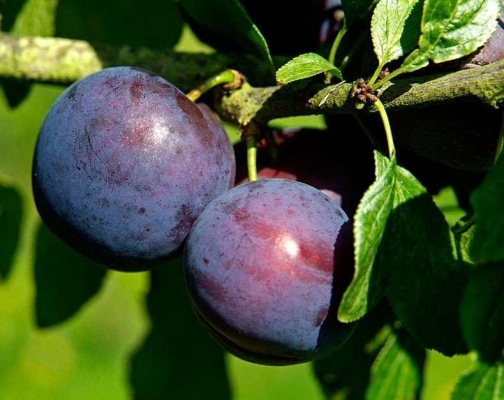Frontier: Fruit is heavy than Santa rosa variety and large in size, peel is deep purplish red in color, sweet, tasty, hard, fragrant, easily get separated from kernels, good storage and matures in end week of June, high yield, grows straight.
Red Beaut: Fruit is medium in shape, globe shaped, red and attractive skin, yellow flesh, sweet and aromatic and sticky in nature with kernel, fruit matures in end week of May, medium size and bears limited fruits.
Teruel: Fruit is medium to large in size, yellow in color, slightly reddish, yellow flesh, sweet, good fragrance, sticked with kernel, matures in second week of July, medium size and gives high yield.
Other state varieties:
Alubokhara: - The plant is erect and also dispersing. The berries are of bigger in dimension compared to other cultivars. The yield is significantly less compared to kala Amritsari. The epicarp is yellowish in shade with reddish patches. Pulp is luscious and sweetened.
Satluj Purple: - This is a self-unfruitful cultivar also needs Kala Amritsari as being pollinizer. Kala Amritsari plum needs to be established like alternating plant in other rows for attaining decent fruits. The berry is of average in dimensions that weigh 25-30g. The epicarp is dense as well as mesocarp yellowish tinted firm body. The berries are generally consumed fresh. It ripens in initial May as well as produce 35-40 Kg of fruits per tree.
Kala Amritsari: - It is best favored cultivar of plains. Berries are of average dimension, rounded oblate. The epicarp on ripening changes darkish purple. The mesocarp is yellowish in tint with succulent pulp. Fruits are minor acidic in flavor. Berry ripens in 2nd half of May. The fruits are renowned for producing Jam as well as squash.
Titron: - This variety is a self-fruitful cultivar however the yield raises in case Alucha variety is utilized as a pollinizer. Titron variety is not bigger than kala Amritsari. The berry size is not as big as Satluj Purple as well as kala Amritsari. The epicarp is thin compared to kala Amritsari. The flesh is yellow-colored as well as little juicy. Fruits produce 30-35 Kg/ tree.
Kataruchak: - The cultivar was founded in small town Kataruchak of Gurdaspur region in Punjab. The fruits trade overpriced compared to those Kala Amritsari, because of the availability of white bloom on the flesh of fruit. The berry is large in dimensions, heart designed as well as purplish in shade. It ripens soon after kala Amritsari. Fruits produce 45-50 kg/tree. Berry is perfect for jam as well as squash preparation.











